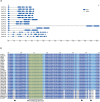Proton-pumping pyrophosphatase homeolog expression is a dynamic trait in bread wheat (Triticum aestivum)
- PMID: 34646976
- PMCID: PMC8496507
- DOI: 10.1002/pld3.354
Proton-pumping pyrophosphatase homeolog expression is a dynamic trait in bread wheat (Triticum aestivum)
Abstract
Proton-pumping pyrophosphatases (H+-PPases) have been shown to enhance biomass and yield. However, to date, there has been little work towards identify genes encoding H+-PPases in bread wheat (Triticum aestivum) (TaVPs) and limited knowledge on how the expression of these genes varies across different growth stages and tissue types. In this study, the IWGSC database was used to identify two novel TaVP genes, TaVP4 and TaVP5, and elucidate the complete homeolog sequences of the three known TaVP genes, bringing the total number of bread wheat TaVPs from 9 to 15. Gene expression levels of each TaVP homeolog were assessed using quantitative real-time PCR (qRT-PCR) in four diverse wheat varieties in terms of phenotypic traits related to high vacuolar pyrophosphatase expression. Homeolog expression was analyzed across multiple tissue types and developmental stages. Expression levels of the TaVP homeologs were found to vary significantly between varieties, tissues and plant developmental stages. During early development (Z10 and Z13), expressions of TaVP1 and TaVP2 homeologs were higher in shoot tissue than root tissue, with both shoot and root expression increasing in later developmental stages (Z22). TaVP2-D was expressed in all varieties and tissue types and was the most highly expressed homeolog at all developmental stages. Expression of the TaVP3 homeologs was restricted to developing grain (Z75), while TaVP4 homeolog expression was higher at Z22 than earlier developmental stages. Variation in TaVP4B was detected among varieties at Z22 and Z75, with Buck Atlantico (high biomass) and Scout (elite Australian cultivar) having the highest levels of expression. These findings offer a comprehensive overview of the bread wheat H+-PPase family and identify variation in TaVP homeolog expression that will be of use to improve the growth, yield, and abiotic stress tolerance of bread wheat.
Keywords: gene expression; gene identification; homeolog; synteny analysis; vacuolar pyrophosphatases.
© 2021 The Authors. Plant Direct published by American Society of Plant Biologists and the Society for Experimental Biology and John Wiley & Sons Ltd.
Conflict of interest statement
The authors declare that they have no conflict of interest.
Figures







References
-
- Adams, K. L. , Cronn, R. , Percifield, R. , & Wendel, J. F. (2003). Genes duplicated by polyploidy show unequal contributions to the transcriptome and organ‐specific reciprocal silencing. Proceedings of the National Academy of Sciences, 100(8), 4649–4654. 10.1073/pnas.0630618100 - DOI - PMC - PubMed
-
- Alexandratos, N. , & Bruinsma, J. (2012). World agriculture towards 2030/2050: The 2012 revision. FAO.
-
- Bao, A. K. , Wang, S. M. , Wu, G. Q. , Xi, J. J. , Zhang, J. L. , & Wang, C. M. (2009). Overexpression of the Arabidopsis H+‐PPase enhanced resistance to salt and drought stress in transgenic alfalfa (Medicago sativa L.). Plant Science, 176(2), 232–240. 10.1016/j.plantsci.2008.10.009 - DOI
LinkOut - more resources
Full Text Sources

